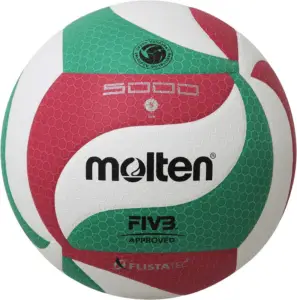Volleyball rules are the first topics to know when starting to play or becoming an expert. Initially, there are some key rules to learn to start playing. Overall, here are examples of the most common volleyball rules for indoor volleyball:
Most Common Volleyball Rules
- Playing Area 1.1 Dimensions: The first volleyball rules cover what makes the volleyball court. The playing court measures 18 meters x 9 meters (29’6″ x 59′). 1.2 Boundaries: The playing court is surrounded by a free zone which is a minimum of 3 meters wide on all sides. 1.3 Ceiling Height: The minimum height clearance for the playing court is 7 meters (23′).
- Teams 2.1 Number of Players: Each team consists of six players on the court at a time. 2.2 Substitutions: Each team is allowed 12 substitutions per set. 2.3 Starting Line-Up: The starting line-up must be submitted to the official scorer prior to the match.
- Equipment 3.1 Ball:
The ball shall be spherical, made of leather or synthetic leather, a circumference of 65-67 cm (25.6-26.4 in) and a weight of 260-280 g (9.2-9.9 oz). 3.2 Net: The net is 2.43 meters (8 feet) high for men and 2.24 meters (7 feet 4 inches) high for women. Initially, it should be 1 meter wide and extend beyond the side lines. 3.3 Antennae:
The antennae are vertical rods placed on opposite sides of the net and extend 80 cm (31.5 in) above the net. - Scoring 4.1 Rally Point System: A point is awarded to the team that wins the rally. The first team to score 25 points with a two-point advantage wins the set. Overall, if a fifth set is needed, the first team to score 15 points with a two-point advantage wins the set. 4.2 Rotation: Players rotate clockwise each time their team wins a rally and the right to serve.

More Rules of Volleyball
- Match Procedures 5.1 Service: The server must serve from behind the end line and within the confines of the service area. 5.2 Reception: Players may not block or attack a serve from the opponent in the front zone. 5.3 Blocking: A player may block an opponent’s attack at the net, but the blocker may not touch the net. 5.4 Attack: An attack is any action used to direct the ball towards the opponent’s court, excluding a serve and a block. 5.5 Substitutions: Substitutions can be made at any time, but only when the ball is out of play. 5.6 Timeouts: Each team is allowed two timeouts per set. The timeout duration is 30 seconds.
- Violations 6.1 Foot Fault: A foot fault occurs when a player steps on or over the end line when serving. 6.2 Net Fault: A net fault occurs when a player touches the net during play. 6.3 Out of Bounds: A ball is considered out of bounds if it lands outside the playing area or contacts an object outside the playing area. 6.4 Double Contact: A double contact occurs when a player touches the ball twice consecutively or the ball comes to rest on any part of a player’s body.
In conclusion, this is just a basic review of the rule book for indoor volleyball. Overall, it is important to note that different leagues and organizations may have their own variations or modifications of these rules.
Rules in Volleyball Conclusion
Finally, here are some links to the most common volleyball rule books:
- USA Volleyball (USAV) Rule Book – This is the official rule book for volleyball competition in the United States:
https://indd.adobe.com/view/f27fc70f-e33f-4e78-b718-67b4ff2af0e0 - Volleyball Canada Rule Book – This is the official rule book for volleyball competition in Canada: https://volleyball.ca/uploads/Development/Referee/Rules/Rulebook_Files/Current_Year/2022-23_VC_Rulebook_-_En_Final.pdf
Lastly, check out more articles found on: dennyfalls.com
